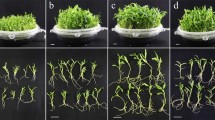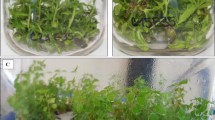Abstract
Dendrobium nobile Lindl. (D.nobile) is a perennial herb of the orchid family and is commonly used in traditional Chinese medicine. Due to the scarcity of D.nobile resources, the market faces a shortage. To improve cultivation efficiency and reduce costs, a temporary immersion bioreactor system (TIBS) is used to meet market demand. The optimal cultivation conditions for D.nobile tissue culture seedlings have been determined through experimental research. These conditions include a liquid medium consisting of 1/2 MS, 30 g/L sucrose, 80 g/L potato juice, 0.5 mg/L NAA, 60 g/L banana juice, and a pH of 6.0. The optimal inoculation volume of TIBS per canister was 22% plant/V D.nobile seedlings, and the optimal submergence frequency of TIBS was set at 5 min/8 h, and the optimal submergence time was set at 6 min/6 h. It was also observed that the endophytic fungus MD33 had a significant impact on plant growth and the dendrobine-type total alkaloids (DTTAs) content, and the accumulation of DTTAs content of D.nobile tissue culture seedlings was significantly higher than that of the control group at 25 days, with an increase of 40.61% (P < 0.001). This study demonstrates that utilising TIBS for cultivation and co-cultivating with endophytic fungus significantly increased the biomass and bioactivity of D.nobile tissue culture seedlings.
Key message
By utilizing the TIBS and co-cultivating with endophytic fungus MD33, we explored a method to achieve high-throughput cultivation of D.nobile seedling and enhance the production of secondary metabolites in D.nobile seedling.






Similar content being viewed by others
Data Availability
The authors are unable or have chosen not to specify which data has been used. The data will be made available on request.
References
Chaves FC, Gianfagna TJ, Aneja M, Posada F, Peterson SW, Vega FE (2012) Aspergillus Oryzae NRRL 35191 from cofee, a non-toxigenic endophyte with the ability to synthesize kojic acid. Mycol Prog 11:263–267. https://doi.org/10.1007/s11557-011-0745-2
Chen Y, Wang Y, Lyu P, Chen L, Shen C, Sun C (2019) Comparative transcriptomic analysis reveal the regulation mechanism underlying MeJA Induced Accumulation of alkaloids in Dendrobium Officinale. J Plant Res 132:419–429. https://doi.org/10.1007/s10265-019-01099-6
Escalona M, Lorenzo JC, González B, Daquinta M, González JL, Desjardins Y, Borroto CG (1999) Pineapple (Ananas comosus L. Merr) micropropagation in temporary immersion systems. Plant Cell Rep 18:743–748. https://doi.org/10.1007/s002990050653
Gao M, Jiang W, Wei S, Lin Z, Cai B, Yang L, Cong L, He X, Tan J, Chen L (2015) High-efficiency propagation of Chinese water chestnut [Eleocharis dulcis (Burm.f.) Trin. Ex Hensch] using a temporary immersion bioreactor system. Plant Cell Tiss Organ Cult (PCTOC) 121:761–772. https://doi.org/10.1007/s11240-015-0732-4
Gaussier P, Revel A, Banquet JP, Babeau V (2002) From view cells and place cells to cognitive map learning: processing stages of the hippocampal system. Biol Cybern 86(1):15–28. https://doi.org/10.1007/s004220100269
Ivanov I, Georgiev V, Georgiev M, Ilieva M, Pavlov A (2011) Galanthamine and related alkaloids production by Leucojum aestivum L. shoot culture using a temporary immersion technology. Biochem Biotechnol 163(2):268–277. https://doi.org/10.1007/s12010-010-9036-7
Jova MC, Kosky RG, Cuellar EE (2011) Effect of liquid media culture systems on yam plant growth (Dioscorea alata L.‘Pacala Duclos’). Biotechnol Agron Soc Environ 15:515–521
Kim NY, Hwang HD, Kim JH et al (2020) Efficient production of virus-free apple plantlets using the temporary immersion bioreactor system. Hortic Environ Biotechnol 61:779–785. https://doi.org/10.1007/s13580-020-00257-3
Li Y, Tao W, Cheng L (2009) Paclitaxel production using co-culture of Taxus suspension cells and paclitaxel-producing endophytic fungi in a co-bioreactor. Appl Biochem Biotechnol 83:233–239. https://doi.org/10.1007/s00253-009-1856-4
Li R, Liu T, Liu M, Chen F, Liu S, Yang J (2017) Anti-influenza a virus activity of dendrobine and its mechanism of action. J Agric Food Chem 65:3665–3674. https://doi.org/10.1021/acs.jafc.7b00276
Li Z, Wen W, Qin M, He Y, Xu D, Li L (2022) Biosynthetic mechanisms of secondary metabolites promoted by the interaction between endophytes and plant hosts. Front Microbiol 13:928967. https://doi.org/10.3389/fmicb.2022.928967
Long YL, Wang W, Zhang Y, Zhang S, Li Z, Deng J, Li J (2023) Dendrobium Nobile Lindl polysaccharides attenuate UVB-induced photodamage by regulating oxidative stress, inflammation and MMPs expression in mice model. Photochem Photobiol 99(5):1269–1281. https://doi.org/10.1111/php.13780
Makowski W, Królicka A, Tokarz B, Szopa A, Ekiert H, Tokarz KM (2023) Temporary immersion bioreactors as a useful tool for obtaining high productivity of phenolic compounds with strong antioxidant properties from Pontechium maculatum. Plant Cell Tiss Organ Cult (PCTOC) 153:525–537. https://doi.org/10.1007/s11240-023-02487-6
Melviana AC, Esyanti RR, Mel M, Setyobudi RH (2021) Biomass enhancement of Stevia rebaudiana bertoni shoot culture in temporary immersion system (TIS) RITA® bioreactor optimized in two different immersion periods. in E3S Web of Conferences. 226:9. https://doi.org/10.1051/e3sconf/202122600007
Münire E, Meltem B, Özge A, Aynur G (2019) High-frequency protocorm-like bodies and shoot regeneration through a combination of thin cell layer and RITA® temporary immersion bioreactor in Cattleya Forbesii Lindl. Plant Cell Tiss Organ Cult (PCTOC) 136:451–464. https://doi.org/10.1007/s11240-018-1526-2
Niemenak N, Noah AM, Omokolo DN (2013) Micropropagation of cocoyam (Xanthosoma sagittifolium L. Schott) in temporary immersion bioreactor. Plant Biotechnol Rep 7:383–390. https://doi.org/10.1007/s11816-013-0272-5
Qian X, ** H, Chen Z, Dai Q, Sarsaiya S, Qin Y, Jia Q, ** L, Chen J (2021) Comparative transcriptome analysis of genes involved in sesquiterpene alkaloid biosynthesis in Trichoderma Longibrachiatum MD33 and UN32. Front Microbiol 12:800125. https://doi.org/10.3389/fmicb.2021.800125
Rahman MZ, Islam SMS, Chowdhury AN, Subramaniam S (2015) Efficient microtuber production of potato in modified nutrient spray bioreactor system. Sci Hortic 192:369–374. https://doi.org/10.1016/j.scienta.2015.06.014
Ramírez-Mosqueda MA, Bello-Bello JJ (2021) SETIS™ bioreactor increases in vitro multiplication and shoot length in vanilla (Vanilla planifolia jacks. Ex Andrews). Acta Physiol Plant 43:52. https://doi.org/10.1007/s11738-021-03227-z
Ramos-Castellá A, Iglesias-Andreu LG, Bello-Bello JJ et al (2014) Improved propagation of vanilla (Vanilla planifolia jacks. Ex Andrews) using a temporary immersion system. In Vitro Cell Dev Biol Plant 50:576–581. https://doi.org/10.1007/s11627-014-9602-8
Rico S, Garrido J, Sanchez C, Ferreiro-Vera C, Codesido V, Vidal N (2022) A Temporary Immersion System to improve Cannabis sativa micropropagation. Front Plant Sci 13:895971. https://doi.org/10.3389/fpls.2022.895971
Sarsaiya S, Jain A, Fan X, Jia Q, Xu Q, Shu F, Zhou Q, Shi J, Chen J (2020) New insights into detection of a dendrobine compound from a novel endophytic Trichoderma longibrachiatum strain and its toxicity against phytopathogenic bacteria. Front Microbiol 11:337. https://doi.org/10.3389/fmicb.2020.00337
Smeekens S, Ma J, Hanson J, Rolland F (2010) Sugar signals and molecular networks controlling plant growth. Current opinion in plant biology 13(3):(2010):273–278. https://doi.org/10.1016/j.pbi.2009.12.002
Szopa A, Kokotkiewicz A, Bednarz M, Jafernik K, Luczkiewicz M, Ekiert H (2019) Bioreactor type affects the accumulation of phenolic acids and flavonoids in microshoot cultures of Schisandra chinensis (Turcz.) Baill. Plant Cell Tiss Organ Cult (PCTOC) 139:199–206. https://doi.org/10.1007/s11240-019-01676-6
Trentini GE, Rojas M, Gajardo D, Alburquenque D, Villagra E, Gómez A, Arru L, Arencibia AD (2021) Elicitation of phenylpropanoids in maqui (Aristotelia chilensis [Mol.] Stuntz) plants micropropagated in photomixotrophic temporary immersion bioreactors (TIBs). Plant Cell Tiss Organ Cult (PCTOC) 146:607–619. https://doi.org/10.1007/s11240-021-02097-0
Uma S, Karthic R, Kalpana S, Backiyarani S (2023) Evaluation of temporary immersion bioreactors for in vitro micropropagation of banana (Musa spp.) and genetic fidelity assessment using flow cytometry and simple-sequence repeat markers. South Afr J Bot 157:553–565. https://doi.org/10.1016/j.sajb.2023.04.006
Vendrame WA, Xu JJ, Beleski DG (2023) Micropropagation of Brassavola nodosa (L.) Lindl. Using SETIS™ bioreactor. Plant Cell Tissue Organ Cult (PCTOC) 153:67–76. https://doi.org/10.1007/s11240-022-02441-y
Wang Z, Gao W, Liu X, Chen P, Lu W, Wang F, Li H, Sun Q, Zhang H (2019) Efficient production of polysaccharide by Chaetomium Globosum CGMCC 6882 through co-culture with host plant Gynostemma Pentaphyllum. Bioprocess Biosyst Eng 42:1731–1738. https://doi.org/10.1007/s00449-019-02169-8
Ye H, Luo S, Yang Z, Wang Y, Ding Q, Wang K, Yang S, Wang Y (2021) Endophytic fungi stimulate the concentration of medicinal secondary metabolites in houttuynia cordata thunb. Plant Signal Behav 16:1929731. https://doi.org/10.1080/15592324.2021.1929731
Zhang B, Song L, Bekele LD, Shi J, Jia Q, Zhang B, ** L, Duns GJ, Chen J (2018a) Optimizing factors affecting development and propagation of Bletilla striata in a temporary immersion bioreactor system. Sci Hortic. https://doi.org/10.1016/j.scienta.2018.01.007. 232:121⁃126
Zhang B, Sarsaiya S, Pan X, ** L, Xu D, Zhang B, Duns GJ, Shi J, Chen J (2018b) Optimization of nutritional conditions using a temporary immersion bioreactor system for the growth of Bletilla striata pseudobulbs and accumulation of polysaccharides. Sci Hortic 240:155–161. https://doi.org/10.1016/j.scienta.2018.06.010
Zhang J, Xu H, Zhao Z, **an Y, Lin Z (2021) Dendrobium nobile lindl: A review on its chemical constituents and pharmacological effects. Chinese Medicine and Culture, 2021(4): 235–242. https://doi.org/10.4103/CMAC.CMAC_44_21
Zhang Q, Fu X, Liu H, Chen Y, Chen S, Niu H, Luo Y, Lei H, Zhang D (2023) A systematical review on ethnobotanical, phytochemical and pharmacological aspects of Dendrobium Nobile Lindl. Phytochem Rev 22:743–780. https://doi.org/10.1007/s11101-023-09858-z
Zhu LH, Li XY, Welander M (2005) Optimisation of growing conditions for the apple rootstock M26 grown in RITA® containers using temporary immersion principle. In: Hvoslef-Eide, A.K., Preil, W. (eds) Liquid Culture Systems for in vitro Plant Propagation 253–261. https://doi.org/10.1007/1-4020-3200-5_17
Acknowledgements
This study was supported by the Bioresource Institute for Healthy Utilization.
Funding
This work was supported by [National Natural Science Foundation of China] (Grant numbers [82373981]) and [The Jiangsu Synergetic Innovation Center for Advanced Bio-Manufacture] (Grant numbers [No. XTC2208]).
Author information
Authors and Affiliations
Contributions
CYW conducted the experiments and wrote the manuscript. QX and YTF analysed the data, investigation and revised the article. SS recheck the English language of the manuscript. JQ and CJS planned and designed the study.
Corresponding author
Ethics declarations
Conflict of interest
the authors confirm that this article content has no conflict of interest.
Additional information
Communicated by Jericó Jabín Bello-Bello.
Publisher’s Note
Springer Nature remains neutral with regard to jurisdictional claims in published maps and institutional affiliations.
Rights and permissions
Springer Nature or its licensor (e.g. a society or other partner) holds exclusive rights to this article under a publishing agreement with the author(s) or other rightsholder(s); author self-archiving of the accepted manuscript version of this article is solely governed by the terms of such publishing agreement and applicable law.
About this article
Cite this article
Cao, Y., Qian, X., Yu, T. et al. Improving biomass and dendrobine-type total alkaloids (DTTAs) production of Dendrobium nobile through combining Temporary Immersion Bioreactor System (TIBS) with endophyte MD33 elicitation. Plant Cell Tiss Organ Cult 156, 9 (2024). https://doi.org/10.1007/s11240-023-02653-w
Received:
Accepted:
Published:
DOI: https://doi.org/10.1007/s11240-023-02653-w




